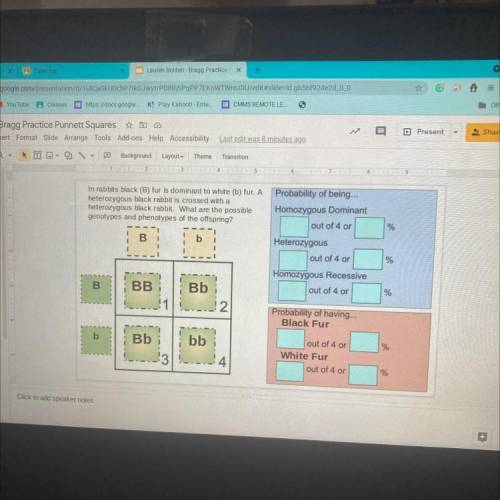
Biology, 03.02.2021 21:00 labrandonanderson00
In rabbits black (B) fur is dominant to white (b) fur. A
heterozygous black rabbit is crossed with a
heterozygous black rabbit. What are the possible
genotypes and phenotypes of the offspring?


Answers: 2
Another question on Biology

Biology, 21.06.2019 20:00
Read the following scenario to answer the following question. over the past 60 years, many amphibian species have experienced significant population declines, and some species have become extinct. scientists suspected that local human activities such as the destruction of wetlands, regional pollution, and deforestation were the main reasons for these losses. however, research over the past 20 years reveals significant amphibian population declines in protected areas of the world, such as nature preserves and parks. these global declines suggest widespread problems including increased ultraviolet radiation, acid rain, and disease. in switzerland, for example, 14 of the 20 native amphibian species are threatened with extinction. when most populations of a wide-ranging amphibian species are lost and the few remaining populations are widely separated, we expect to see that a. the founder effect becomes increasingly important b. microevolution no longer occurs c. gene flow between populations is reduced d. artificial selection becomes a greater factor in microevolution
Answers: 2

Biology, 21.06.2019 23:30
Mutations associated with albinism affect proteins involved in synthesis
Answers: 1

Biology, 22.06.2019 03:30
Rease is an enzyme used by plants to break down urea (a nitrogen-containing compound) into carbon dioxide and ammonia. urease urea > > > carbon dioxide and ammonia ammonia is broken down by plants into a nitrogen source plants need to grow. thus, plants could not use urea as a nitrogen source unless it was first converted to ammonia. in soybean plants there are two different kinds of urease, one produced in the seeds and the other produced in the leaves of the plant. three types of soybean plants were used in a set of experiments: normal soybeans and two mutant strains, one lacking the urease in the seeds only (strain 1) and one lacking urease in the leaves only (strain 2). experiment 1 separate areas in a field were planted with normal, strain 1, and strain 2 soybeans. all types of soybeans appeared to grow, flower, and produce seeds equally well. there were no externally detectable differences among the strains. experiment 2 small pieces of plant leaves of equal weight were obtained from each type of soybean plant and separately placed on media in culture dishes. tissue growing in this way will become an unorganized clump of cells referred to as callus. to provide a controlled nitrogen source, half the tissue samples of each type were placed on media containing urea, and the other half of the samples were placed on media containing ammonia. after 30 days, the weight gain for each of the callus samples was determined. results are shown in the table below.
Answers: 2

Biology, 22.06.2019 04:00
Indicate the coat color and the proportion of offspring with that color for each of the following crosses of rabbits. assume all are homozygous. chinchilla x chinchilla 1/2 agouti, 1/2 chinchilla 3/4 agouti, 1/4 chinchilla all chinchilla
Answers: 3
You know the right answer?
In rabbits black (B) fur is dominant to white (b) fur. A
heterozygous black rabbit is crossed with...
Questions

Biology, 16.12.2019 18:31




History, 16.12.2019 18:31


World Languages, 16.12.2019 18:31

Biology, 16.12.2019 18:31

History, 16.12.2019 18:31

Health, 16.12.2019 18:31

History, 16.12.2019 18:31

English, 16.12.2019 18:31

Business, 16.12.2019 18:31

Biology, 16.12.2019 18:31

Mathematics, 16.12.2019 18:31


History, 16.12.2019 18:31

Chemistry, 16.12.2019 18:31

Mathematics, 16.12.2019 18:31

Mathematics, 16.12.2019 18:31



